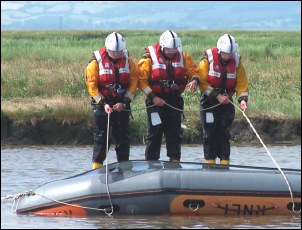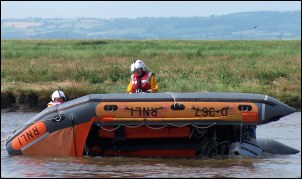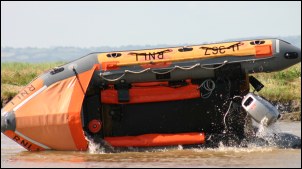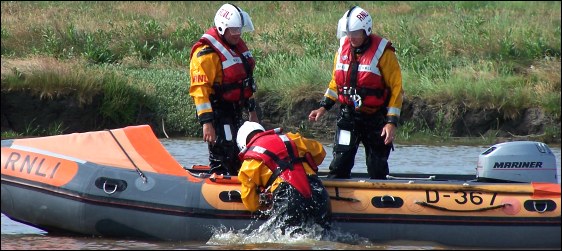Burnham RNLI Home Page > Burnham RNLI News Archive
June 26, 2005
Burnham-On-Sea RNLI crew practise what they’d do if a lifeboat capsized
Burnham-On-Sea RNLI crew members have been rehearsing how they would react if a lifeboat flipped over or capsized out at sea.
Some 20 crewmembers gathered in a calm area of water at the mouth of the River Brue, near the Yacht Club, on Sunday morning (June 26) to run through the correct capsize recovery procedure.
 Lifeboats often encounter hazardous conditions at sea and therefore it’s vital that the crew know what to do in the event of their craft capsizing.
Lifeboats often encounter hazardous conditions at sea and therefore it’s vital that the crew know what to do in the event of their craft capsizing.
It is for this reason that all Burnham RNLI crewmembers undergo compulsory capsize training.
Some lifeboats are designed to be self-righting, and some have to be righted by the use of a gas flotation bag. The smaller D class lifeboats have to be righted manually – and this is what was practised this week.
 After righting a capsized lifeboat, various procedures are followed, including removal of the outboard engine cowling and replacement of the engine’s spark plugs to ensure all water has been cleared from the inside the engine before it is restarted.
After righting a capsized lifeboat, various procedures are followed, including removal of the outboard engine cowling and replacement of the engine’s spark plugs to ensure all water has been cleared from the inside the engine before it is restarted.
This can be a difficult and time-consuming task even when in the calm waters of the River Brue, let alone in a heavy sea when preservation of life is at stake and the clock is ticking.
 The photos on this page show step-by-step how the lifeboat crew flip the lifeboat over – from being stranded upside down to being the right side up again.
The photos on this page show step-by-step how the lifeboat crew flip the lifeboat over – from being stranded upside down to being the right side up again.
The capsize exercise is just one part of an extensive ongoing training programme at Burnham-On-Sea RNLI which all crew participate in.

RELATED LINKS:







